1
James Anderson (1812-1867)1862
Georgina Pioneer Village & Archives
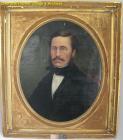 Credits:
Credits:Georgina Pioneer Village & Archives
2
-James Anderson was born 15 January 1812 in Calcutta, India; son of Robert Anderson and Eliza Charlotte Simpson.-He was educated in London.
-He left Britain, and entered service with the HBC in 1831 as an apprentice. The same year, his father immigrated to Canada and his brother Alexander Caulfield Anderson also entered HBC service.
-Initially, he was posted to Moose Factory at the southern end of James Bay.
-During his first winter, he played a major role in the arrest, trial and execution of a group of First Nations people convicted of the murder of HBC employees in Hannah Bay.
-16 September 1839 he married Margaret Mackenzie. Her father was Chief Factor Roderick Mackenzie Sr. of the HBC, and her mother was a First Nations woman named Angelique.
-In 1847, he was posted to Nipigon, where he was promoted to Chief Trader.
-In 1850, he was transferred to the Northern Department, and posted to Fort Chipewyan, where he was placed in charge of the Athabasca District.
-Beginning in 1851, he was Chief Trader at Fort Simpson for 8 years, in the Mackenzie River District, where he improved the chaotic accounting system.
-He increased profits through retrenchment in the upper Yukon basin: he abandoned Frances Lake, Pelly and Fort Selkirk posts to cut company losses. Under his management, the annual average profit was raised from £19 291 in 1844-50 to £24 756 in 1851-57.
-He was promoted to Chief Factor 14 June 1855 while preparing for the Back River expedition.
-In 1855, he headed the search for the Franklin Expedition.
-He returned to Fort Simpson after the expedition, and resumed his duties of running the Mackenzie River District.
-Anderson's health had been undermined by the arctic expedition. He intended to retire in '57, but instead went on furlough (a leave of absence usually granted to employees after the termination of one contract, before beginning a new contract).
3
-He was reengaged in '58, and placed in charge of Mingan for a year, a less remote post, on the north shore of St Lawrence, which he made more profitable.-In 1861, he bought Ainslie Hill Farm in North Gwillimbury Township, Canada West.
-He resigned due to ill-health in 1864, and retired to Georgina Township.
-He died 16 October 1867, of tuberculosis. He was survived by his wife, 6 sons, and 1 daughter.
4
James Anderson's Letter of Appreciation; framed1 December 1857
Georgina Pioneer Village & Archives
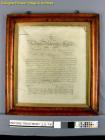 Credits:
Credits:Georgina Pioneer Village & Archives
5
James Anderson's Letter of Appreciation; unframed1 December 1857
Georgina Pioneer Village & Archives
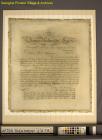 Credits:
Credits:Georgina Pioneer Village & Archives
6
A map showing James Anderson's travels across the continent1831-1864
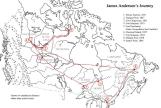 Credits:
Credits:Created in Photoshop using
http://www.canadainfolink.ca/LAKES.JPG
http://www.historycooperative.org/journals/ohq/104.4/images/swagerty_fig03b.jpg
7
A Brief Biography of James Anderson
James Anderson's Decision to Join the Hudson's Bay Company
8
James and his brother Alexander Caulfield Anderson met two veteran HBC Chief Factors at a dinner party.Alexander wrote in his journal: "I longed for a life of adventure in the to me mysterious wilderness of the West. My yearnings, already sufficiently excited, received afterwards a fresh impulse. I met at a dinner party two veteran Chief Factors of the Hudson's Bay Company, at home on furlough - John Clarke and Alexander Stewart. Stirring anecdotes of adventure by flood and field filled my attentive ears and confirmed the desire, if indeed it ever wavered, that I had formed in favour of the West. To be brief, it was decided that I should join the Hudson's Bay Company, in which service I was duly accepted as an 'Apprentice Clerk.'"
Both James and Alex accepted posts as apprentice clerks with the HBC in 1831. The brothers were courageous in coming to Canada, which was a vast, wild, and unexplored land. James, especially, had to face the extreme cold of the north.
9
A Brief Biography of James Anderson
Family Members Also with the Hudson's Bay Company
Alexander Caulfield Anderson
10
James Anderson's brother, Alexander Caulfield, was born 10 March 1814 near Calcutta, India. He also entered service with the Hudson's Bay Company in 1831. When they arrived in Canada, James was posted in the north-west, but Alex stayed at Lachine for a year, and the two brothers never saw each other again.In 1832, Alex was sent to Fort Vancouver, a voyage which took him more than three months. He became a skilled traveller, as, to deliver furs to the point where they could be carried across eastern Canada to the Atlantic Ocean, he had to journey through the forests of British Columbia, and over the Rocky mountains, to the prairies - over half a continent.
Throughout his service with the Hudson's Bay Company, he was active in exploration west of the Rocky Mountains. He was the namesake of Anderson Lake, Anderson River (a tributary of the Fraser), and Anderson Island, in Puget Sound near Nisqually.
11
James's brother, Alexander Caulfield Anderson (1814-1884), trader and explorer with the HBCCirca 1880
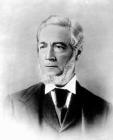 Credits:
Credits:British Columbia Archives, Call #A-01075, Catalogue #HP002228
http://upload.wikimedia.org/wikipedia/commons/4/46/Alexander-caulfield-anderson.jpg
12
James's brother Alexander Caulfield Anderson18 February 1970
Sutton, Ontario, Canada
 Credits:
Credits:Alexander Bourchier Anderson, 1884-1971
Georgina Pioneer Village & Archives
13
A Brief Biography of James Anderson
Family Members Also with the Hudson's Bay Company
George Anderson